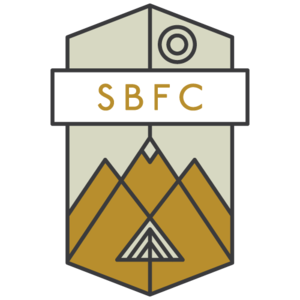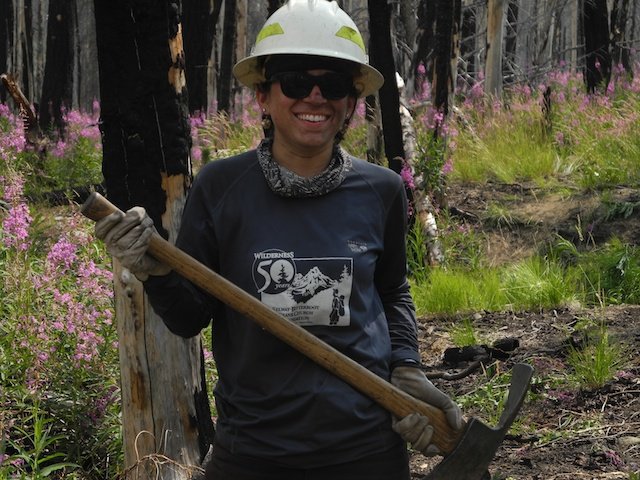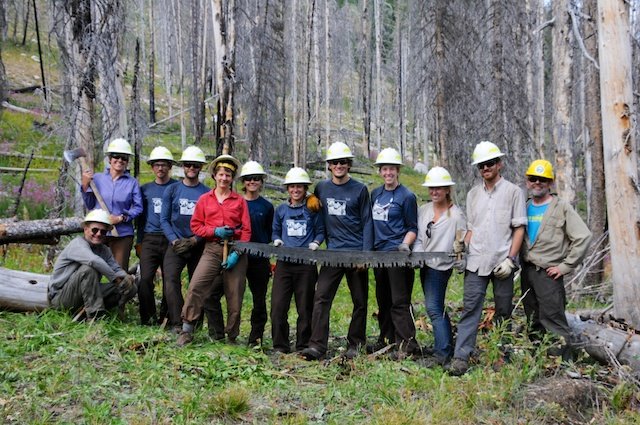Name: Susie (Irizarry) Sidder
Wilderness Ranger Fellow in what year?: 2014
Why did you want to join SBFC as a Wilderness Ranger Fellow?
Susie on a hitch at Indian Creek. The realities of working in a burn area!
I did the Fellowship right after finishing my master’s degree in Natural Resources at the University of Idaho. I moved to Idaho from the east coast to study wilderness and natural resources management from a human dimensions perspective. I wanted to understand people who are recreating on public lands, specifically what are their behaviors and how can we change behaviors to protect resources?
Ed Krumpe, an SBFC board member, taught two of my wilderness classes at the University of Idaho. Through Ed and those classes, I learned about the Wilderness Ranger Fellowship and thought that it would be an excellent opportunity to be on the ground and see what working as a manager is like.
What experiences stood out to you the most during your time as an SBFC Fellow? Most memorable, or most poignant?
The main thing that sticks out to me from the experience was how empowering it was as a woman to push myself in the wilderness and know that I could do it! It was so formative to enter the space of learning traditional wilderness tools and growing the confidence to be able to problem solve and do work in the backcountry.
I’m from Florida originally and my family did not grow up camping and backpacking. These are skills I’ve learned as an adult. Living in Idaho was my first exposure to truly wide-open spaces. Getting my brain wrapped around wilderness as a management entity was impactful… I had read about crosscut saws and traditional tools and skills and understood the terminology, but actually doing it was so empowering!
I’m 5’2” and was definitely intimidated by the idea of carrying a 50+ pound pack plus tools in my arms. However, I had a strong sense of determination going into the Fellowship. The staff at SBFC were so supportive and working with the other women (and men) in my cohort was great.
Did you have an “ah-ha!” moment as a Fellow? What was the most important lesson you learned during your time?
Things started to click together when I was working with some other Fellows in the Frank. We were working in an area that hadn’t been maintained for a LONG time. It was an area that fire had burned through many years ago, and it was regrown… the fireweed was hip high. After the burn, the landscape reclaimed the area.
I think that experience of working through and reestablishing the trail through a burnout was an a-ha moment for realizing how so many factors come together in wilderness management. I typically approach things through human dimensions/recreation and focus on understanding the people-side of land management and think about wilderness in terms of opening trails for access. That experience on the fire trail was very eye-opening in terms of the larger forces (such as fire) that wilderness managers in the west are dealing with, and help determine how we manage the land.
A group of fellows and volunteers posing for a photo after clearing the last log from the trail. Susie is in the very center of the group, 6-in from either side.
On another hitch that summer, we went back to the same place and brought a volunteer crew. It was a beautiful experience to be part of a volunteer hitch where volunteers could experience stewarding an area. Bringing people to the wilderness to connect with the land was, and continues to be, so important.
Those two hitches and seeing all these factors at play were so impactful for me. My takeaway was the realization of what it means to manage wilderness in our modern context.
What has been your career path since your time with SBFC?
Right after SBFC I worked in consulting with the National Park Service to implement social science broadly throughout the NPS and address visitor use and social science information needs to inform park planning and management. Some of the projects I contributed to touched on wilderness, but most were geared to protected areas more broadly.
Susie preparing to hike to Little Yosemite Valley as part of a training and field scoping trip for an ongoing project wilderness character and travel pattern study with Yosemite National Park (September 2021)
Now I’m a PhD candidate at Oregon State University, focused on applied social science and human dimensions. I’m still focused on wilderness and understanding travel patterns and behaviors of both users in remote/difficult to access and in high use wilderness around Yosemite. My research is geared to predictive modeling of recreational visitor movement in protected areas, with the goal of providing managers with information and maps to help in proactive management and resource stewardship.
My academic and career trajectory has always been working towards federal lands management… either through partnerships, private sector work, or academic cooperatives. Today, I continue to work in the public lands management arena, not as a land manager, but as a researcher to support planning efforts and research on the ground.
I plan to finish my PhD in the Fall. I’ve been teaching a Wilderness Management course at Oregon State for upper level undergraduates for the past two fall quarters and am excited to teach it one last time during the 2022 Fall term. As I wrap up my degree, I’m starting to look for the next opportunity, ideally continuing to work on applied land management and wilderness issues as a federal land manager or as a partner.
Any advice for people who want to follow in your footsteps—especially women who want to get involved within this industry?
My advice is that it’s important to seek out opportunities that allow you to be on the ground and see what’s going on! Whether you want to be a manager in an agency or in a supportive role, there are so many different avenues to work in to serve the greater public lands mission of preserving and protecting our land for today’s generation and future generations. I think it’s so important to seek out a variety of experiences- even paths that don’t seem like they will be “the path.” For me, when I was looking for opportunities after my masters, every time I thought about applying for SBFC Fellowship, I had a feeling that I should just go for it! I had to stop worrying about underlying questions like, will this be my path forever? You have to be nimble and focused on a broad goal but realize that there are so many lenses and ways to get there. The experiences that you have will shape you, broaden your network, change the way you view problems, and mold you into the career path and professional that you are meant to be.
Taking the SBFC Fellowship was taking a chance on something that ordinarily I wouldn’t have done, but it was far and above one of my most formative experiences.
Now I can tell agency partners that I’ve built trail and used a crosscut! It helps to build connections and bridges within this field/arena. The common shared experience of what trail work is and means goes a long way when working on complex and often difficult to resolve land management issues.
Susie with a tree she logged out during her summer with SBFC.




